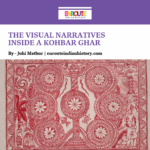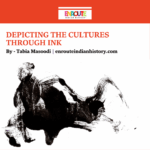Article Written By EIH Researcher And Writer
Bhavya Saini
A walk around the Marine Drive, evening at Juhu Beach, snacking at Chowpatty, shopping in Colaba – so much to explore yet the true face of Mumbai resides in its chawls and slums. Established in the 1900s by the British Government, these chawls rehabilitated the migrant labourers who came to work in Bombay at the newly started textile mills. Gradually, these chawls facilitated communal life to thrive as people became more used to the lifestyle.
While the Indian hip-hop music has become more popular among the youth in the recent years, it can be dated back to more than a decade, even before 2010, when it existed in the form of online communities such as Orkut and Facebook groups – “These communities often used to organise online cyphers (rap battles) in which two artists sent their poetry ‘dissing’ each other, and their peers voted to declare a winner.” These hip-hop enthusiasts often originated from the deprived slums like Dharavi and Kurla, drew inspirations from rap legends like Eminem, Sean Paul and 50 Cent, yet could hardly afford to curate their talent into albums while struggling to even survive between the cramped urban spaces. At a time when producing their own albums seemed like an unachievable dream for these artists, the advent of social media platforms like YouTube became a fertile ground for the young talent to express their art and expression. Indian hip-hop rapper Naezy aka Naved Sheikh was inspired by Sean Paul’s Temperature at the young age of 13 and in 2014, he shot his first single, Aafat, on an iPad with zero budget which has more than five million views on Youtube now. Many rap artists acknowledge the role of technology and social media in making their music more accessible to the audience as well as making international artists more accessible to them that inspired them to chase their passions.

Naved Sheikh aka Naezy. Credits: MensXP
However, accessibility is not the only factor in the increasing popularity of these rap artists. One of the major reasons why this music has caught the attention of the Indian youth is its theme. The Bombay rappers do not comply with the lavish and luxury life depicted in the songs of Punjabi rappers – the ones that show women dancing in clubs, glorify a life of the riches with expensive cars and clothes – their songs attempt to portray the realities of life – the everyday struggle of survival in a fast-moving urban space, the corrupted and dysfunctional system and a desire to break through it. Their songs are a reflection of the society and an effective alternative to the escapist fantastical world provided by the Punjabi rap songs. “Delhi had a bustling Punjabi rap/hip-hop scene. But they made songs about cars, alcohol, girls. We rapped about our gully, our city. It was genuine, authentic Indian hip-hop,” Divine mentioned in an interview about his 2015 song featuring Naezy, Mere Gully Mein, which narrated an original story of the everyday life of these Gully boys – “a story of the streets”. Such songs, in Bombaiya-tapori style, discussed the deep-rooted corruption, incompetency of the government, the family struggles, police brutality, or any topic which compelled the artist to speak; in a language which is understood and celebrated by all.

A still from Mere Gully Mein song from Gully Boy
The Maharashtra Government envisages the redevelopment of Dharavi, known to be the largest slum area in Asia. However, this initiative has also witnessed many protests and disagreements since it does not take into account the small and informal businesses that have thrived over the years in the area. The future of rag pickers and small vendors is at stake as only a part of the area is believed to be used for housing and the rest will come under commercial establishments. Jayanti Datta, in her essay, recalls Sanjeev Sayal who remarks, “Creating neat low income housing estates will not work unless they allow for many of the messy economic and social activities that thrive in the slum.” Datta also mentions about the various rap groups that have formed in Dharavi with the rise of hip-hop culture as a means of expression. While her study revolves around the ‘deprived’ slums of Dharavi, a consensus of the rap artists revealed that they “did not consider themselves poor or underprivileged. They did not want to harp upon despair or deprivation. They rather wanted to assert their fighting spirit and their readiness for struggle.”
While Zoya Akhtar’s 2016 film Gully Boy was a great attempt to make the audience familiar with this underground rap culture in India and served as a means of promoting art while celebrating the right to expression, rap group 7 Bantaiz felt that the reality of Dharavi as a place of hard work and labour was rather romanticised in the film. Datta comments, “The paradigm of the single individual making it big by the dint of his resources somewhere undermines the underlying unity of the Dharavi boys.”
The new economic policy of the 1970s did not only result in the inclusivity of the trade world with the advent of globalisation, but it also facilitated the movement of ideas, beliefs and cultures across countries. The Bombaiya-tapori rap may have been inspired by the American rap culture, but it has created an identity of its own at a global level. In her essay, Datta defines rap as “a kind of urban folklore, which is being used to create and define the identity of an emerging community to itself as well as to others.” On the other hand, Ashwini Mishra aka A List describes rap as tangible since a single artist can write about a multitude of topics ranging from partying and women, to social and cultural issues. These boys attempt to recreate Dharavi as the world knows it while trying to change its ways. A Stan, from the 7 Bantaiz, told Datta in a personal interview, “Now, young girls and boys are no longer trying to hide the place
of their origin, they are proud now, proud that they belong to Dharavi. I believe we did this, all of us rappers, we created it. We are creating itihas.” These ‘Gully Boys’ are not just rapping to achieve their dreams and fame, but they want to teach the people of Dharavi by calling out the unjust system and making their struggles heard.
References
Datta, Jayanti. “Mumbai Rap – A New Sense of the Sacred.” PostScriptum: An Interdisciplinary Journal of Literary Studies, vol. V, July 2020, 234-239. DOI 10.5281/zenodo.3972285
https://www.sahapedia.org/voice-streets-hip-hop-sociocultural-expression-dharavis-youth
https://www.thehindu.com/news/cities/mumbai/hip-hop-on-the-central-line/article7983134.ece



















